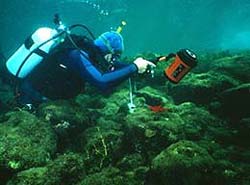Ecology, The Environment and Conservation
This complex theme deals primarily with interactions between organisms and the environmental factors that impact them, but to a greater extent between individual inanimate environmental factors.
innovations-report offers informative reports and articles on topics such as climate protection, landscape conservation, ecological systems, wildlife and nature parks and ecosystem efficiency and balance.

U.S. and Australia allies against marine invasion
Thirty three marine species are poised to invade Australian waters, and could seriously alter the balance of marine life or even pose a risk to human health if they reach our coasts.
In an international response to the threat, researchers from CSIRO and the Smithsonian Environmental Research Center, Maryland, have joined forces to develop a rapid response strategy to combat invasion.
CSIRO risk assessment scientists have identified the most damaging marine species from around the

Warming temperatures put tufted puffin at risk
Warmer ocean temperatures may be harming reproduction of the tufted puffin in western Canada and if global temperatures continue to increase, the species could be at risk, says a new study co-authored by a University of Alberta researcher.
Throughout the last two decades, uncharacteristically warm sea-surfaces have persisted near Triangle Island–off the coast of British Columbia–a haven for these birds. Researchers have been studying the reproductive performance of tufted puffins there si

Dodging elephants, scorpions, mudslides … UF researcher tracks tigers
Of the estimated 7,000 tigers left in the world, scientists know the least about the roughly 2,000 thought to remain in Southeast Asia.
Unstable or repressive political conditions in Vietnam, Cambodia, Thailand, Laos, Myanmar and Malaysia have long impeded Western biologists trying to study tigers there. Much of the big cats’ habitat, meanwhile, consists of remote, extremely wild rain forest that offers near-perfect cover to the shy and elusive predators.
So tiger experts are h

City-grown air pollution is tougher on country trees
A tree grows in Brooklyn — despite big-city air pollutants. Meanwhile, identical trees planted downwind of city pollution grow only half as well — a surprising finding that ecologists at Cornell University and the Institute of Ecosystem Studies (IES) reported in the current issue of Nature (July 10, 2003). They attribute the effect to an atmospheric-chemistry “footprint” that favors city trees.
“I know this sounds counterintuitive but it’s true. City-grown pollution — and ozone in parti

Columbia researchers divide world according to evolutionary genetics
Monkeys and toads define priority areas for conservation on a fine geographic scale
Scientific determinations of 25 global “hotspots” – habitats with high concentrations of unique species vulnerable to human activity – are too large to be effectively managed by local conservation authorities, much less put aside as protected areas. Researchers from the Center for Environmental Research and Conservation (CERC) are making even finer geographic distinctions within these ’hotspots

Farming the tigers of the sea undermines the promise of aquaculture
New report points out the high ecological and social costs of farming
Providence, RI – SeaWeb, an ocean conservation organization, today released its report, “What Price Farmed Fish: A Review of the Environmental and Social Costs of Farming Carnivorous Fish,” authored by Michael Weber, a marine conservation consultant. This timely report examines the impacts of farming salmon and warns that the trend toward farming additional carnivorous fish species, including tuna, cod, and halibut